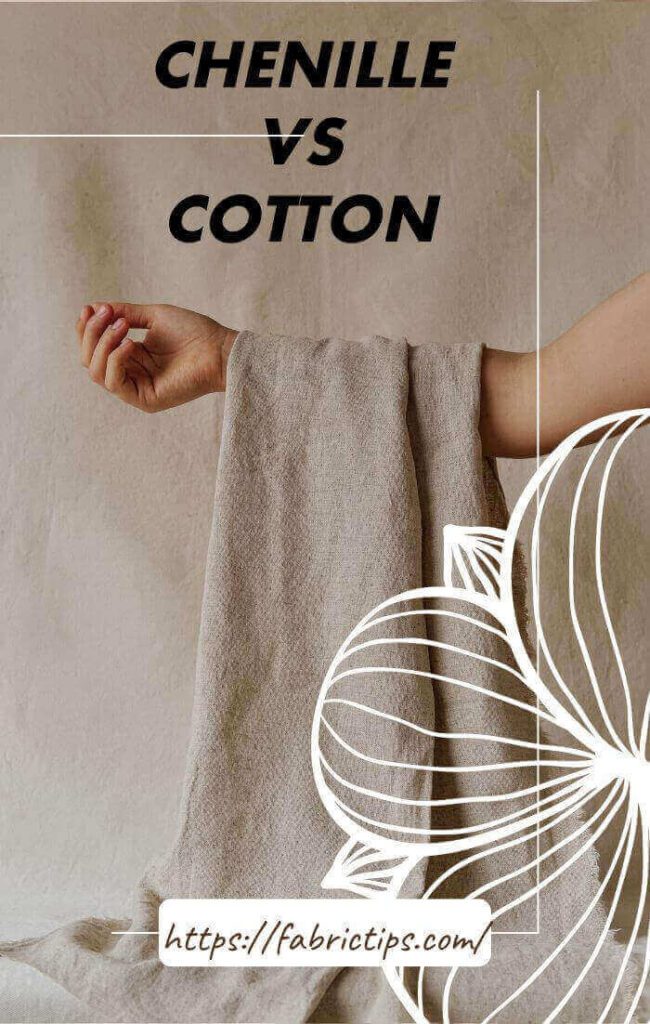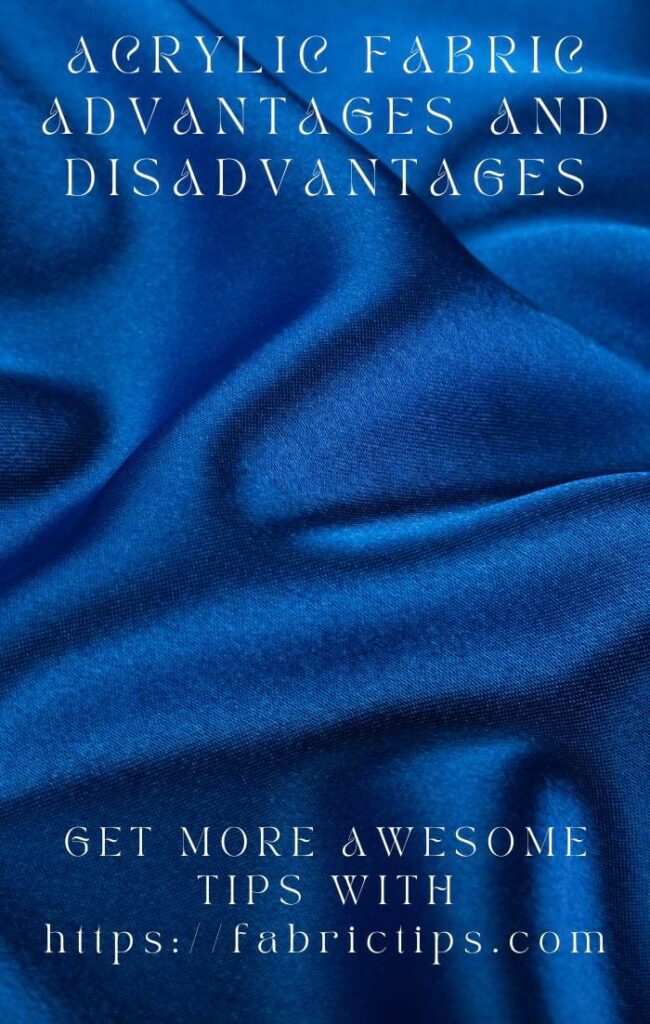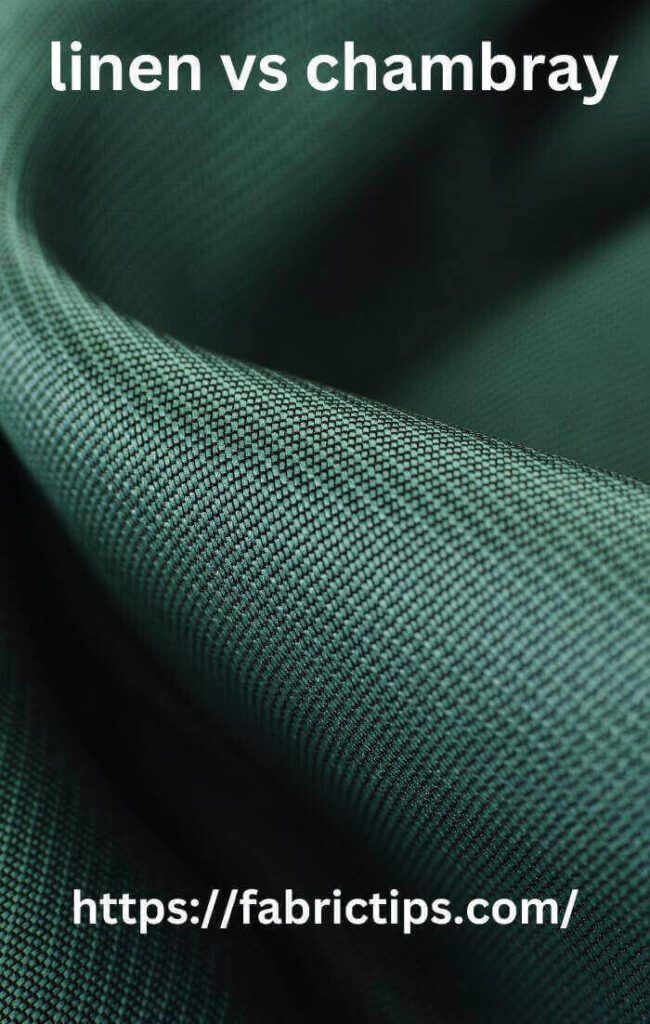Last Updated on December 13, 2025 by Wahid
Are you designing for athletes who require a breathable & flexible fabric? Would you like to decorate for electricians who need to wear fabrics that won’t melt on their skin when they are exposed to sparks? Luckily, Cotton is a great choice, and Chenille can be best too.
Basically, Cotton is a type of fiber. However, Chenille is a type of fabric. The result is that Chenille can be woven from any fabric fiber. Chenille is a weaving or processing method for fibers, in contrast to Cotton, which is a woven vegetable fiber.
Compared to Cotton, Chenille is heavier and thicker, while Cotton is lighter and more breathable. Chenille is the best material of choice for winter clothing. Anyways, Cotton is your best friend during the summer months.
In case you’ve never dealt with fabrics before, you might not be familiar with Chenille and Cotton. Even though Chenille Vs Cotton are both created with 100% cotton fiber, their manufacturing processes can still differ. Chenille Vs Cotton: Which is more comfortable to use? Don’t worry about it. Here’s everything you need to know. Let’s find them out.
Chenille Vs Cotton: Briefly Specification Table
Although both Chenille and Cotton can be your best one, you should know their key characteristics first. Let’s see in the below table:
| Chenille | Cotton | |
| Fiber content:- | Cotton, silk, rayon, wool | Cotton |
| Manufacturing method:- | Weaving | Spinning |
| Texture:- | Soft & fuzzy | Soft & smooth |
| Maintenance:- | Clean is easier | Clean is hard |
| Breathability:- | Not breathable | Breathable |
| Price:- | Cost-effective | Expensive |
| Weight:- | Heavier and thicker | Lightweight |
Chenille Vs Cotton: A Comprehensive Discussion
What Is Chenille Fabric?

Chenille is a word derived from the French meaning caterpillar. Caterpillars are known for their fuzzy exterior, which is why it is called that. In chenille fabric, threads are intentionally piled together to produce a fuzzy appearance.
Chenille is usually found in fabrics, but it is also very common to use chenille yarns in quilting, these yarns being referred to as “faux chenille”. Generally speaking, Chenille is a very soft fabric.
Where Does Chenille Come From?
Putting short sequences of yarn together, called the “pile,” produces chenille yarn. By twisting the yarn between 2 “core yarns,” the yarn becomes Chenille. Therefore, these piles’ edges confront the yarn’s core, which gives Chenille its distinctive appearance as well as its softness.
Chenille will appear different from one side to the next, as its fibers reflect light differently. There is no need to use iridescent fibers to make Chenille appear iridescent. In most cases, cotton yarn is made, but rayon, olefin, and acrylic can also be used.
What Is Cotton Fabric?

Worldwide, cotton fabrics are among the most common types of material. Textiles are made from organic fibers, meaning they don’t include any synthetic chemicals.
Cotton fabric is usually made from cotton plant fibers that surround the seeds, which develop into a round, fluffy shape once they are mature.
Where Does Cotton Come From?
Clothing made from Cotton has been used in Mexico and Peru for 5,000 years. In the ancient cultures of India, Egypt, China, and Pakistan, Cotton was also grown, spun, & woven.
Cotton does not naturally grow in Western Europe. Before A.D. 800, Arab traders brought Cotton to Spain. During the 14th century, Mediterranean farmers cultivated cotton plants, and their fiber was shipped to the Netherlands for weaving and spinning. The late 1700s saw the introduction of water-driven spinning machines, which revolutionized hand spinning.
A young American named “Samuel Slater”, an expert in British machines, learned the machine’s designs. Then he returned home to establish Slater Mill in Rhode Island, the first machine-spinner textile mill in the United States. The mill is representative of the start of the American industry, based on cotton production.
Chenille Vs Cotton: Advantages & Disadvantages
Chenille Advantages
As you can see, Chenille has many advantages, which may make you overlook some disadvantages. Take a look at these benefits of using Chenille:
- There is a lovely fuzzy texture to the fabric, and it is quite soft to touch. Winter fashion is made easier by the fact that it also keeps you warm.
- This item features a sleek design that gives your home furniture a stunning appearance.
- Different colors are available, so you can select one that suits your taste.
- This fabric is very durable and thick, making it ideal for furnishing homes.
- High water absorption is a characteristic of this fabric.
- It makes excellent drapes, and it’s a great option for making curtains.
- This fabric has multiple uses. It can be used in a variety of ways.
Chenille Disadvantages
When purchasing Chenille, you should also consider its disadvantages. If not, it may not feel as good as advertised. Chenille may have the following drawbacks:
- Chenille is an excellent option for home furnishings; however, it is difficult to clean if something spills on it.
- By stretching the fabric, its elasticity may be lost. Consequently, it can’t be reshaped again.
- Despite the soft fabric, upholstered furniture still requires strong, durable construction beneath the fabric.
- The heavy weight makes it challenging to wash. Maintaining its quality is extremely difficult.
- When kept close to a door, or window, the fabric color might fade. It fades when exposed to sunshine, or wherever direct sunlight enters.
- When you clean the fabric, it might shrink or deform, and it won’t iron smoothly.
Cotton Advantages
It has been proven that cotton fibers provide better sleep than fibers made of synthetic fibers. In addition, Cotton is naturally breathable, meaning that the covers don’t trap heat.
Cotton fiber has a number of advantages. Some of them are:
- The price is reasonable,
- And it has good absorbency.
- Furthermore, it has good breathability.
- Additionally, it is more easily cleaned and cared for compared to others.
- Cotton clothes are the best to wear during working hours.
- Moreover, cotton clothes are very comfortable.
Cotton Disadvantages
The following disadvantages are of them:
- The material does not resist wrinkles.
- There is a risk of stretching or shrinking.
- Some cotton takes a long period of time to dry.
- Some colors can fade under the sun.
Because it is heavy, Chenille is extremely difficult to clean. However, Cotton is much easier to clean and maintain and a lot handier.
Chenille Fabric Uses

The Chenille fabric is versatile and can be applied to almost anything. Whether it is for clothing or home decor, this fabric can be used anywhere.
Clothing
A Chenille sweater is famous for its ability to keep you warm and stylish at the same time. Although the fabric is heavy, it does not appear baggy.
Home Decor
Chenille is suitable for couches, drapes, upholstery, bedspreads, and so much more. With its iridescent appearance, it makes your home look magnificent.
Rugs And Carpets
Rugs and carpets made with Chenille are of high quality due to their durability. The heavyweight is capable of keeping your carpets & rugs in place.
Blankets
Choosing Chenille as your comforter material is a perfect choice because of its soft, fluffy texture. In winter, you enjoy sleeping in Chenille. For keeping warm, Chenille blankets & comforters are a popular choice.
Quilting
Since the 1990s, Chenille has been used for quilting. The fabric is used in yarns, finishes, and yards. Using different chenille patches, one can create actual chenille quilts that have different patterns & colors. Depending on the design, chenille quilts have ragged seams, or they don’t.
Shawls
Chenille was originally created to create fashionable shawls. This is because the fabric is soft and drapes beautifully.
Uses of Cotton

Cotton has a variety of uses options, as shown in the following:
House And Home textiles
Table cloths, kitchen cloths, bed cloths, hand towels, carpets, furniture covers, bath towels and many more as well.
Accessories
Trimmings, laces, ribbons, kerchiefs, handkerchiefs, umbrellas, etc.
Apparel Fabrics
Nightwear, shirts, blouses, leisure wear, rain wear, trousers, etc.
Industrial Textiles
Clothing for workers, cords, sewing threads, shoes, bags, medical supplies, and a wide variety of other items are also available options as well.
Characteristics Of Chenille Fabrics

The Chenille fabric features fluffy piles that look like caterpillars. Chenille is one of the newest textile trends. The first time it was used was in the 18th century, but it has gained popularity among fashion designers recently.
- Comfortable
- Fluffy
- Lightweight
- Wearable and warm
- Frays easily
- Velvety Pile
- Flexible
- Good Drape
- Versatile
- Flattens when pressed
- Fabrics with different characteristics can be made using different warp yarns.
Characteristics Of Cotton Fabrics

Cotton is most commonly used to produce thread-applying cotton gins, which can have numerous domestic & industrial uses.
- Comfortable
- Non-elastic
- Light weight
- Feels soft
- An excellent drape quality
- Color retention is excellent
- Super absorbent
- Machine washing is possible
- Dry cleanable
- An excellent cooling property
- Great strength
- Extremely shiny
- Dries fast
- Very durable
- Outstanding moisture absorption
- A wet fiber is more resistant
How To Maintain Chenille Fabrics
Keeping the Chenille healthy requires more than just periodic cleaning. It must be appropriately maintained. You can maintain Chenille by following these valuable tips:
- The fabric should never be machine washed. Machine washing will shrink the fabric and cause damage.
- To extend the life of your cushion, rotate it at least once per week.
- Don’t let your fabric come into direct contact with dyes or corrosives. If you do, the dyes or corrosives will ruin your fabric.
- When your fabric has an X on it, do not try to spot clean it yourself.
- It is always a good idea to read the instructions on your fabric. The instructions should explain how to clean and take care of the fabric.
- Call a professional if you want your couch and upholstery deep cleaned and safety clean as well.
How To Maintain Cotton Fabric
Cotton is a fabric available in so many types, and is used in so many ways, that it is difficult to provide advice about how to wash it. Before washing your cotton item, make sure you check the label first.
- Always use cold water (30°C or lower), whether you wash it by hand or in a machine.
- When T-shirts are washed and dried, Cotton tends to shrink. In order to avoid this, try the following:
- It is always best to let garments air dry. If possible, lay the clothes flat & away from direct sunlight.
- When garments come out of the washer, give them a gentle stretch to bring them back to shape.
- When you have a garment that is known to shrink more than 10%, wash it by hand with cold water.
- The iron temperature setting should be determined by the care label on the garment.
- When ironing cotton items, it is better to use a slightly damp cloth, or you can use your iron steam setting.
- When folding and storing the items, make sure they are dry/aired perfectly.
FAQs
01. Exactly What Is Organic Cotton?
Cotton is grown there without toxic chemicals in any part of the growing process. Organic Cotton is produced by growing cotton plants organically. In addition, no chemicals, fertilizers or pesticides are used during the growing process, and the fabrics are unbleached and dyed using a natural plant that is healthy.
02. Why Is Cotton The Best Fabric?
Fabrics made from Cotton tend to be more durable & resistant than those of other natural fibers. These characteristics make cotton fabrics resistant to wear and tear. The durability of Cotton is excellent. Cotton is durable, strong, and unlikely to tear or rip because of its high tensile strength. Additionally, its fibers strengthen by 30% when wet – so let’s play water balloons!
03. Is Chenille Fabric Similar To Velvet?
A Chenille is soft, fuzzy, and looks like a caterpillar, which makes it different from velvet. Velvet that is crushed and fuzzy can also be known as Chenille. The fabric is made up of Cotton, rayon, acrylic, and olefin.
04. What Is Vegan Chenille?
Chenille is sometimes vegan when the material is made of synthetic or Cotton. While wool or silk can be mixed with yarn, it won’t be considered vegan.
05. Exactly What Is Cotton Chenille?
The fabric is made from fuzzy cotton yarns whose pile protrudes at the weave. As its name suggests in French, this fabric looks like a caterpillar! The material’s softness makes it ideal for blankets, bedding, pillows, sweaters, and upholstery.
06. Is Chenille An Acrylic Fabric?
Chenille can be made to appear iridescent even if it does not use Iridescence fibers. Typically, Cotton is used to make yarn, but acrylic, olefin, and rayon can also be used.
07. Chenille Is Cotton, Right?
Chenille is a stronger fabric than others and also looks great. It is sometimes possible to make Chenille from Cotton, so cotton chenille is no different from Cotton in terms of its advantages & disadvantages. Chenille is typically crafted from rayon or olefin, synthetic fabrics that are easy to maintain and clean.
08. Cotton Vs Jute – What’s The Difference?
Fabrics made from Cotton come from the soft fibers surrounding the cotton seeds. The plant’s stalks are held up by its tough fibers, while jute is composed of the stalks. The fibers from these plants are quite different, which is why they perform different functions in nature. Threads of Cotton are just like natural packing peanuts, which are quite soft, delicate, and fluffy. As jute fiber has to be sturdy enough to withstand storms and wind, then they tend to be coarse and stiff.
09. How Does 100% Cotton Differ From Organic Cotton?
There isn’t a difference that can be detected by sight, touch, odor, or using a microscope that could distinguish between 100% cotton and 100% organic cotton. In contrast, growers & mills certify that organic Cotton is produced without pesticides and chemical fertilizers.
10. Melange Cotton: What Is It?
A melange, also called heather, occurs when different colors are mixed together, such as in fabrics, yarns, or fibers. To create the melange, or heather effect, yarns or fibers of 2 or more colors are blended together. Melange cotton refers to its texture and composition, which refers to the fabric that is made from 100% cotton fibers but mixes 2 and more colors.
11. What Makes Egyptian Cotton Different From Regular Cotton?
Another important difference is the appalling conditions of labor in Egypt. Younger boys are forced to pick Cotton as slaves. Cotton balls often contain blood because of their sharp edges. Machines pick American Pima cotton. They also import American Pima cotton, which is called “Egyptian” Cotton.
12. What Are The Different Types Of Cotton?
Cotton comes in different varieties. One of their main differences is their staple length. There is medium staple cotton, long-staple cotton, & extra long staple cotton. Cotton with longer staples produces fine yarn. Higher-quality dress material is made with finer yarns; therefore, it has a better feel and texture. This is why long Cotton has a higher price tag.
The Bottom Line
The difference between Chenille Vs Cotton is well known to you. Chenille is a durable and high-quality fabric that is popular among textile manufacturers. If you are planning to make some changes to your house, then you will need to choose fabrics that match your style and make an impact.
When you know what Chenille is, you might want to consider using it as one of your top choices and why it’s so good for your home decor.
You can share your previous experience with us; we will be happy to hear from you. Well, comment below.


